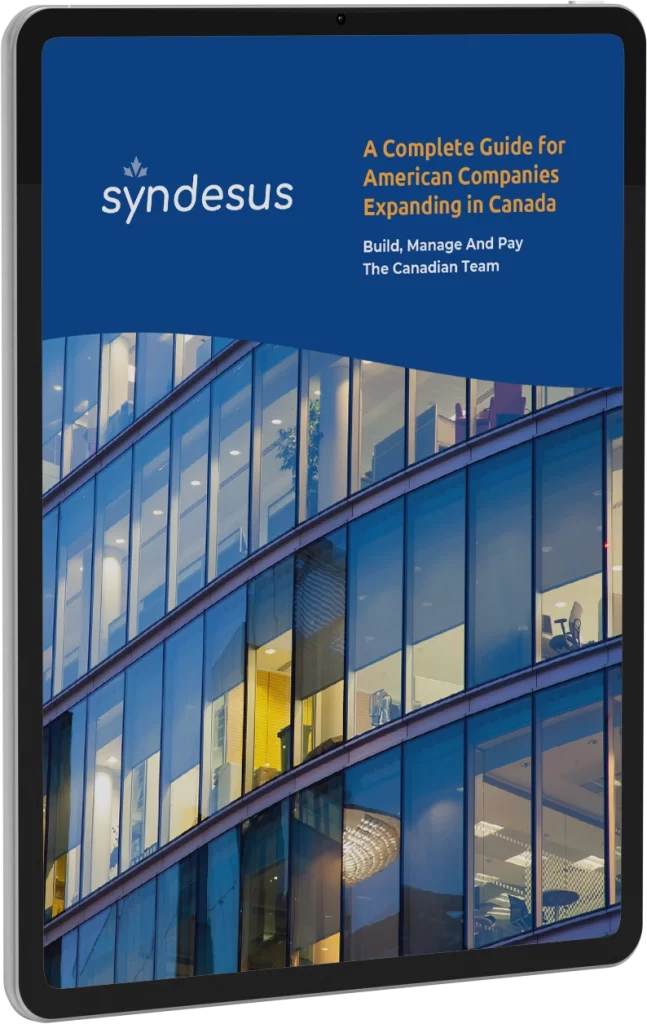Major US-based companies, particularly tech companies, are reaching into Canada and opening or expanding their offices.
The growing trend can be attributed to several factors, including the complicated and lengthy H-1B visa application process in the US, making it difficult to hire and retain tech talent, and the relatively straightforward immigration programs and strong social benefits in Canada.
Though it is easy to assume that a company needs to be of a certain size before expanding internationally, it’s actually easier to do than many companies think. Smaller US companies might want to benefit from this as well, but how? Instead of opening up an entire office, which can be expensive and time-consuming, there are other options.
Two services that can help both small and mid-size US companies expand internationally are an Employer of Record (EOR) and a Professional Employer Organization (PEO). These services help ensure compliance with local employment laws, manage tax, payroll, and benefits, plus even support or handle the immigration process if it’s needed.
But PEOs and EORs are terms that are sometimes used interchangeably even though the two have some important differences.
This article explores the key differences between PEOs and EORs, helping you make an informed choice that aligns with your company’s structure and growth aspirations.
Benefits of PEOs:
- Enhanced Compliance: PEOs help client companies navigate complex regulatory landscapes and ensure compliance with local labor laws, tax regulations, and employment standards.
- Streamlined Operations: By outsourcing HR functions to a PEO, companies can streamline administrative processes, reduce paperwork, and optimize resource allocation.
- Access to Expertise: PEOs offer specialized expertise in HR management, legal advice, benefits administration, and compliance, enabling client companies to leverage best practices and industry insights.
- Scalability: PEOs provide scalable solutions that adapt to the evolving needs of client companies, allowing for seamless expansion into new markets and workforce growth.
- Risk Mitigation: PEOs assume shared responsibility for HR-related risks, including employee lawsuits, compliance violations, and payroll errors, thereby mitigating potential liabilities for client companies.
Benefits of EORs:
- Rapid Market Entry: EORs enable swift entry into new markets by assuming legal employer responsibilities on behalf of the client company, eliminating the need for establishing a local entity. It’s a quick way to start establishing international teams.
- Cost-Effective Expansion: By leveraging the services of an EOR, companies can expand their operations globally without the upfront costs and overhead associated with setting up offices or subsidiaries.
- Flexibility: EOR arrangements offer flexibility and agility, allowing companies to scale their workforce up or down based on market demand and business requirements.
- Compliance Assurance: EORs ensure compliance with local labor laws, employment regulations, and tax requirements, minimizing the risk of non-compliance and associated penalties.
- Focus on Core Activities: By offloading tasks from your HR team to an EOR, client companies can focus on core business activities, innovation, and strategic growth initiatives.
Understanding PEO and EOR Fundamentals
PEOs and EORs serve as vital components in navigating the complexities of global workforce management and delving into global employment. A Professional Employer Organization (PEO) extends beyond basic HR services to encompass a spectrum of responsibilities, including payroll, compliance, and risk management. On the other hand, an Employer of Record (EOR) legally employs individuals on your company’s behalf, assuming HR responsibilities such as payroll, taxation, and compliance.
A PEO enters into a co-employment relationship with client companies, sharing responsibility for employees while allowing the client to maintain legal employer status. Conversely, an EOR assumes full legal employer responsibilities, making it an attractive option for businesses navigating international waters.
A key takeaway is that a PEO requires the company to already have an established entity in Canada while an EOR allows you to hire full-time employees in a new location where you do not have an established entity.
Co-Employment Dynamics with PEO
In a co-employment relationship with a PEO, human resources responsibilities and benefits are shared between the PEO and the client company. The PEO manages tasks such as payroll, benefits administration, and compliance, while the client maintains day-to-day operational control. This partnership offers a safety net for managing workplace risks and ensuring compliance with labor laws.
In stable markets, a PEO offers comprehensive HR support, covering everything from onboarding to regulatory compliance. By leveraging PEO services, businesses can ensure seamless integration of HR expertise into their operations while maintaining operational control.
EOR as the Legal Employer
Opting for the EOR path involves assigning the EOR the role of the legal employer, with responsibilities spanning compliance, employee benefits, workers’ compensation, and employment contracts. EORs excel in navigating local labor laws and managing payroll in multiple currencies, making them indispensable for businesses eyeing global expansion.
Global Hiring and Access to International Top Talent
Hiring international employees through an Employer of Record (EOR) or a Professional Employer Organization (PEO) offers significant benefits for small and medium-sized businesses. These services streamline the process of expanding into new markets like Canada by handling compliance with local employment laws, tax management, payroll processing, and benefits administration.
With an EOR, companies without a legal presence in the target country can efficiently and cost-effectively hire local staff, as the EOR assumes legal employer responsibilities, reducing liability for the hiring company.
On the other hand, a PEO is beneficial for companies with an existing presence in the target country, providing additional support and seasonal flexibility with employment tasks while allowing the company to retain liability for its employees. Overall, both EORs and PEOs enable small and medium-sized businesses to access global talent pools, expand internationally, and navigate complex legal and administrative requirements more effectively.
The Impact on HR Strategy and Business Operations
Collaborating with a PEO or EOR has substantial impacts on HR strategy and business operations. PEOs enhance in-house HR capabilities, allowing businesses to focus on core activities, while EORs streamline global expansion, ensuring compliance with local labor laws and regulations.
Legal Liabilities and Risk Management
EORs provide a buffer against compliance risks by assuming legal responsibility for employment law and taxation. Conversely, PEOs share legal responsibility with client companies, fostering a collaborative approach to risk management and ensuring compliance with workplace regulations.
Analyzing Key Differences in Services Offered
PEOs and EORs utilize unique sets of tools to manage HR tasks, with PEOs offering comprehensive HR management and EORs excelling in global payroll and compliance management. While both handle essential HR functions such as payroll processing and benefits administration, their approaches differ based on client needs and operational requirements.
Choosing between an EOR and a PEO hinges on your company’s scale, the scope of international market ambitions, and operational preferences. While a PEO anchors HR needs within existing legal entities, an EOR enables swift global expansion without the burden of establishing local entities. Whether your sails are set for localized growth or international horizons, selecting the right relationship is essential for navigating the complexities of global expansion.
Summary: The Main Differences
- Legal Structure and Responsibility:
- EOR: Assumes full legal employer responsibilities, including payroll, taxation, and compliance. Acts as the legal employer for the employees.
- PEO: Enters into a co-employment relationship with client companies, sharing responsibility for employees while allowing the client to maintain legal employer status.
- Market Entry Approach:
- EOR: Facilitates rapid market entry into new locations by assuming legal employer responsibilities on behalf of the client company, eliminating the need for establishing a local entity.
- PEO: Requires the company to already have an established entity in the target country.
- Cost and Flexibility:
- EOR: Offers a cost-effective expansion solution without the upfront costs and overhead associated with setting up offices or subsidiaries. Provides flexibility in scaling the workforce based on market demand.
- PEO: Provides comprehensive HR support within existing legal entities, offering stability and assistance with employment tasks.
- Compliance and Risk Management:
- EOR: Ensures compliance with local labor laws, employment regulations, and tax requirements, minimizing the risk of non-compliance and associated penalties.
- PEO: Shares legal responsibility with client companies, fostering a collaborative approach to risk management and compliance with workplace regulations.
- Operational Focus:
- EOR: Allows client companies to focus on core business activities, innovation, and strategic growth initiatives by offloading HR and administrative tasks.
- PEO: Enhances in-house HR capabilities, enabling businesses to focus on core activities while receiving support from HR management.
How to Choose
Deciding between a PEO and an EOR requires a strategic assessment of your company’s needs, growth trajectory, and values. While PEOs are ideal for bolstering HR capabilities within existing legal structures, EORs offer comprehensive support for global expansion initiatives. By aligning with the service provider, you can navigate the complexities of workforce management and chart a course toward growth and success.
Both PEOs and EORs offer distinct advantages depending on your company’s business needs. PEOs serve as co-captains in HR management, sharing responsibilities and risks, while EORs assume full legal and operational control. Your decision should be anchored in a strategic assessment of your company’s needs and growth trajectory.
Unlock the Potential of International Expansion with Syndesus
Syndesus can help you with both PEO and EOR services including immigration, benefits, HR, and payroll. Administrative processes are taken care of for you while you focus on expanding your workforce to new locations and moving your company forward.
We can help US companies that don’t have an office in Canada leverage Canada’s tech talent and favorable immigration laws for tech workers, whether those companies are small US startups or large corporations. Or, if you already have a Canadian entity, Syndesus can manage the technical aspects of employment and help grow and maintain your team.
*The content and materials available via Syndesus are for informational purposes only and do not constitute legal advice.

